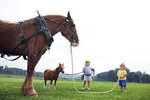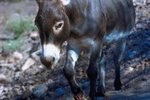First in war, first in peace and first to bring mammoth jacks to this country. That might not be exactly what you learned about George Washington in school, but it's true. Washington, along with other contemporary far-seeing planters and farmers, imported mammoth donkeys from Europe to cross with mares for mule production. Hardier and requiring less feed than horses, mules worked the fields for farmers and pulled freight for the army.
Foundational Breeds
According to the North American Saddle Mule Association, five main breeds of donkey developed today's mammoth breed. The Andalusian, from Spain, is a draft-type donkey usually grey or roan in color, ranging in height from 14.2 to 15 hands. The finer-boned Catalonian donkey, also of Spanish origin and now quite rare, is always black. The Majorcan, another Spanish import and also black, was the largest of all donkeys but no longer exists. From Malta came the Maltese, which were small, black and very tough. The French Poitou possesses a long, dreadlocked coat and is very large-boned. Few purebreds exist today.
Appearance
To qualify as a mammoth jackstock breeding animal, a jack must stand at least 14.2 hands; a jennet must reach 14 hands. Jacks generally weight between 1,000 and 2,000 pounds, the jennets slightly less. Any color is acceptable, but black, chestnut and roan are preferred by breeders of draft mules. The darker gray color of smaller donkeys is looked down upon by breeders. Any breeding animal should possess good conformation and strong bones.
Temperament
Most mammoth donkeys possess a good temperament and a strong work ethic. The ideal mammoth donkey doesn't tire easily, remaining unflappable and willing. Mammoth donkeys take a while to mature but can keep going strong into old age. Avoid putting them into hard work until they are at least 5 years old.
Uses
Mammoth jacks are still used primarily for mule production. Because mammoth donkeys are relatively rare, males are generally not gelded -- they are in demand as breeding stock. Heavier jacks are crossed with draft mares to produce draft mules, while lighter animals are bred to light horse mares for saddle mule production. Many of these mares come from gaited breeds, resulting in gaited mules. Mammoth jacks and jennets can be ridden or trained for driving.
References
Writer Bio
Jane Meggitt has been a writer for more than 20 years. In addition to reporting for a major newspaper chain, she has been published in "Horse News," "Suburban Classic," "Hoof Beats," "Equine Journal" and other publications. She has a Bachelor of Arts in English from New York University and an Associate of Arts from the American Academy of Dramatics Arts, New York City.




